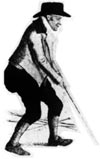| For
those with a taste for the extraordinary in golfing history,
the match between two Scots - a duke and a shoemaker - and
two taunting English nobles, will give satisfaction. And not
least because Scotland won.
 Played
over the old Leith Links in 1680, it was probably the first
international game between the two countries. The young
Scottish duke was, of course, the golf-struck Duke of York,
later to become James VII of Scotland and II of England,
and most of Edinburgh turned out to see the match because
money was at stake. Played
over the old Leith Links in 1680, it was probably the first
international game between the two countries. The young
Scottish duke was, of course, the golf-struck Duke of York,
later to become James VII of Scotland and II of England,
and most of Edinburgh turned out to see the match because
money was at stake.
Like so many others at this time, the
future king had been well smitten by the golf bug. The two
English dukes teased him about his passion and an argument
developed over whether golf had originated in Scotland or
England. Eventually the challenge was thrown down to James,
who immediately accepted and laid a wager on the result.
It was not the first or last time that
a Scot, of royal blood or not, with a reputation or money
to lose, has sought means to give himself an edge. And so
James immediately sent out his runners to find the best
golfer in Edinburgh. They returned with shoemaker John Patersone,
who also made the leather golf balls used in those days.
The entire royal court turned up at
the links, which was then one of Scotland's most famous
golf courses, second only to St Andrews.
The affair had caught the imagination
of the city and side-bets were changing hands among the
crowds. Scotland won and, although the score is not recorded,
James generously handed over half the wager to his golfing
partner.
John Patersone used the proceeds to
build a house at Golfers Land in the Canongate on the Royal
Mile, and it is there to this day.
 It
was back in the early 16th century that golf first cast
its spell on the unsuspecting populace and the golf industry
began. It
was back in the early 16th century that golf first cast
its spell on the unsuspecting populace and the golf industry
began.
Mary, Queen of Scats could hit a lengthy
ball and the monarchs Charles I, Charles II, James IV, JamesVI
and JamesVII (of the United Kingdom) all played over the
historic Leith Links, the site of sieges and hangings.
Club making became an important skill
and by royal command in 1603, William Mayne, maker of bows,
arrows and spears, also became golf club provider to the
king. Golf balls were made of leather, stuffed with feathers
in those days and in 1600 were priced at 'four schillings
money of this realm'.
With the Scottish royal family resident
at Holyrood, and with so many of them being golfing fanatics,
it was not surprising that Scotland's capital became the
fashionable seat of the game.
Courses began to be laid out around
the edges of the old city with newly founded golfing societies.
The Burghers or Burgess Golfing Society, founded in 1735
and now the Royal Burgess, claims to be Scotland's oldest
properly constituted golf club.
Many early club members wore scarlet
coats with their own individual facings and gilt buttons.
Most had their own champions or Cock o' the Green. The dedication
of one of them, the celebrated Alexander McKellar, of Bruntsfield
Links, saw him practicing short holes by lantern light.
It is said he did a dance of delight after each good shot.
Today's Ye Old Golf Tavern on the west
side of Bruntsfield Links, established in the 15th century,
was used as the clubhouse by a number of distinguished golfing
societies playing over the course. Another nearby 18th-century
golfing tavern was Rare Mangy Johnston's, which reputedly
served a particularly potent ale.
|



